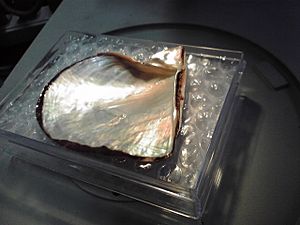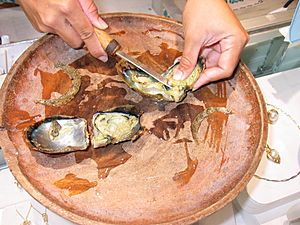Pinctada facts for kids
Pinctada is a group of special saltwater oysters. These amazing sea creatures are a type of bivalve mollusk. This means they have two shells that are hinged together. They belong to the family called Pteriidae, which are known as the pearl oysters.
What makes these oysters so special? Their inner shell has a strong, shiny layer. This layer is called nacre, or "mother of pearl." It's the same beautiful material that pearls are made of!
It's important to know that pearl oysters are different from the oysters people eat. They are also not related to the freshwater pearl mussels found in rivers and lakes.
Two very important types of Pinctada oysters are Pinctada margaritifera and P. maxima. These are used to grow famous South Sea and Tahitian pearls. People grow them widely in the central and eastern Indo-Pacific ocean. You can even see a pearl oyster on the back of the 1,000-peso bill in the Philippines!
Contents
Growing Pearls: The Pinctada Story
All types of Pinctada oysters can create pearls. For a long time, people have tried to collect pearls from many different Pinctada species. Today, only a few species are very important for making pearls to sell.
Important Pearl Oyster Species
Here are some of the Pinctada species that are important for making pearls:
- Gulf pearl oyster: Found in the Persian Gulf, Red Sea, Mediterranean Sea, and all the way to Japan and Australia.
- Black-lip oyster, Pinctada margaritifera: Found in the Persian Gulf, Indian Ocean, Fiji, Tahiti, Myanmar, Baja California, and the Gulf of Mexico.
- Gold-lip oyster and White-lip oyster: Both are types of Pinctada maxima. They live in Australia, Fiji, Tahiti, and Myanmar.
- Pinctada mazatlanica: Found near Mexico and Panama.
- Akoya pearl oyster, Pinctada fucata (also called P. imbricata): Lives in the Red Sea, Sri Lanka, the Persian Gulf, the Indian Ocean, the Western Pacific Ocean, Australia, China, and Venezuela.
- Shark Bay pearl oyster Pinctada albina: Found in Australia.
Different Kinds of Pearls
The different types of Pinctada oysters grow pearls of various sizes and colors. The size of the oyster and the natural color of the nacre inside its shell affect the pearl. For example:
- Black South Sea pearls, also called Tahitian pearls, come from the black-lip oyster.
- White and golden South Sea pearls come from the white-lip and golden-lip oysters.
- Akoya cultured pearls come from Pinctada fucata martensii, the Akoya pearl oyster.
Pearls are also collected from other types of oysters, like the winged oyster genus Pteria. Some freshwater mussels, like Hyriopsis cumingii and Hyriopsis schlegelii, also produce pearls. These freshwater mussels are not related to the pearl oysters.
Life Cycle of a Pearl Oyster

Pearl oysters usually live for about 3 to 14 years. However, because so many people want pearls, these oysters are often harvested sooner.
For example, Pinctada maxima oysters are ready to have a pearl started inside them when they are about 2 years old. It then takes another 2 years for a pearl to fully grow inside them. These oysters can be used to grow new pearls up to 3 or 4 more times! Akoya pearls are harvested much faster, usually after about 9 to 16 months.
A scientist named Aldemaro Romero Jr. studied the history of pearl oysters. He found that one of the first animal groups to be over-harvested by Europeans in America was a type of pearl oyster (Pinctada imbricata). This happened off the coast of Venezuela. He looked at old records and learned about the oysters' biology to understand why they disappeared so quickly.
See also
 In Spanish: Pinctada para niños
In Spanish: Pinctada para niños



